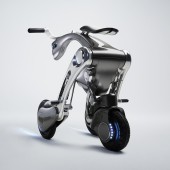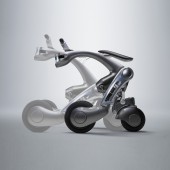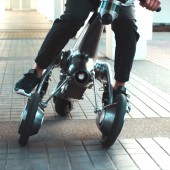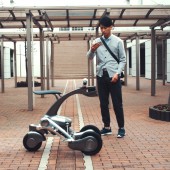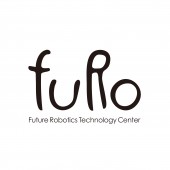CanguRo Mobility Robot by Shunji Yamanaka - fuRo |
Home > Winners > #106350 |
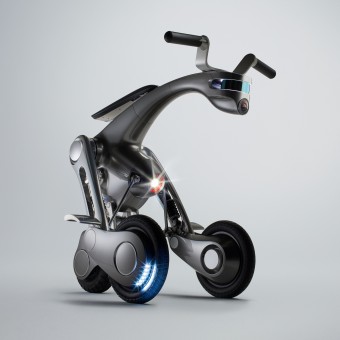 |
|
||||
| DESIGN DETAILS | |||||
| DESIGN NAME: CanguRo PRIMARY FUNCTION: Mobility Robot INSPIRATION: Since old days, horses have been our faithful and reliable partners. They have not only been a means of our transportation, but also lived with us and helped our lives in many ways through carrying loads or going along for hunting. This design project was inspired by the realization of their importance as our close friends. Focusing on their roles in our lives, we have attempted and succeeded to create such a partner using today's civilization technologies. UNIQUE PROPERTIES / PROJECT DESCRIPTION: With CanguRo, we hope to forge a new relationship between machines and humans in the era of artificial intelligence (AI). Blessed with advanced robotics and AI technologies, this three-wheeled robot is an independent yet friendly partner, capable of autonomously coming to you via smartphone commands, avoiding obstacles and following your walk. When it transforms, furthermore, CanguRo is ready to give us an actual ride, being not just a vehicle but a trustworthy creature like a horse. OPERATION / FLOW / INTERACTION: The operation of CanguRo is rather easy. While surroundings are mapped automatically, you can choose either of the autonomous robot or the transporter operation. At a shopping mall, for example, you can summon CanguRo by a smartphone and start shopping while leaving your baggage on the following CanguRo. If you feel tired, you can ride CanguRo in the transporter mode as well. These functionalities of CanguRo have a great potential to change our daily lives and expand the range of our activities. PROJECT DURATION AND LOCATION: This mobility robot was designed and developed in Japan and exhibited at several museums including Cooper Hewitt, Smithsonian Design Museum in New York, 2019 and the Design Museum in London, 2020. FITS BEST INTO CATEGORY: Vehicle, Mobility and Transportation Design |
PRODUCTION / REALIZATION TECHNOLOGY: Essential to a machine intelligence for autonomous navigation is a technology, called SLAM, for localization and map building. Our original software package is successfully implemented with navigation and obstacle-detecting functions. Another importance is on the enhancement of the sense of unity. All the elements that make up this robot, including its figure, structure and various control systems combining familiarity and functionality, are fully designed for this objective. SPECIFICATIONS / TECHNICAL PROPERTIES: This three-wheeled mobility robot has 750 mm in length (in the vehicle mode), 440 mm of width and 64 kg of mass, and is driven by two front wheels (12 inch) and steered by one rear wheel (10 inch). With a laser sensor installed, it can move to a specified destination autonomously and follow a walking human. It can also transform to a personal transporter, featured by active lean balancing, bilaterally weight-controlled handle, body-sonic status communication and automatic braking. TAGS: Mobility Robot, Autonomous Mobile Robot, Partner Robot, Personal Vehicle, Transporter, Artificial Intelligence RESEARCH ABSTRACT: As a new class of partner robots, an actual working model, CanguRo, capable of self-driving, following a walking human as well as transforming to a personal vehicle, has been designed and developed. The primary concept is to promote a sense of unity between the robot and us and to offer the joy of moving, leading to encouragement of going outside and being active in our daily lives. Through its presentations to the society, we continue to evaluate the social value of such a mobility robot. CHALLENGE: Enhancing a sense of unity between the rider and the robot is our challenge. For this purpose, several new ideas are implemented. For example, CanguRo uses tactically placed force sensors to find rider's intentions and changes its posture for stable turns. It also has a unique communication system of heartbeat-like body sonic and bilaterally weight-controlled handle. Footrests are located at swing forks closely to in-wheel drive units, allowing us to feel CanguRo's drive force through our legs. ADDED DATE: 2020-06-02 04:42:56 TEAM MEMBERS (13) : Shunji Yamanaka, Takayuki Furuta, Hideaki Yamato, Kiyoshi Irie, Takashi Kodachi, Kazuki Ogihara, Yoshitaka Hara, Kengo Toda, Yu Okumura, Midori Nomura, Masaharu Shimizu, Tomoaki Yoshida and Masahiro Tomono IMAGE CREDITS: Photo by Yusuke Nishibe PATENTS/COPYRIGHTS: Future Robotics Technology Center (fuRo) |
||||
| Visit the following page to learn more: http://www.furo.org/index_e.html | |||||
| AWARD DETAILS | |
 |
Canguro Mobility Robot by Shunji Yamanaka-Furo is Winner in Vehicle, Mobility and Transportation Design Category, 2020 - 2021.· Press Members: Login or Register to request an exclusive interview with Shunji Yamanaka - fuRo. · Click here to register inorder to view the profile and other works by Shunji Yamanaka - fuRo. |
| SOCIAL |
| + Add to Likes / Favorites | Send to My Email | Comment | Testimonials | View Press-Release | Press Kit |

